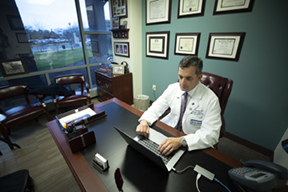Director of the Eastern Virginia Medical School Voice and Swallowing Center
 For the past 18 years, Dr. John Sinacori has led the development of a comprehensive center for Hampton Roads patients with voice, airway or swallowing issues.
For the past 18 years, Dr. John Sinacori has led the development of a comprehensive center for Hampton Roads patients with voice, airway or swallowing issues.
The EVMS program offers the latest medical, surgical and multidisciplinary therapies for simple to complex problems. Laryngoscopes with digital chip technology and stroboscopy now can gather highly detailed views of the vocal folds and visualize vibration up to 700 times a second.
Overall, Dr. Sinacori’s passion is raising awareness about the importance of vocal care. An estimated 40 percent of Americans rely heavily on their voices at work, including singers, actors, teachers, lawyers, ministers, broadcasters, and call center employees.
“Many people ignore signs of voice strain or damage, or don’t realize that we can treat a wide range of pathologies,” he says. “People learn how to lift heavy objects to protect their backs, or wear earplugs to protect their hearing, but we rarely discuss how to protect our voice.”
Dr. Sinacori, who completed a Laryngology Fellowship at Vanderbilt University Medical Center, has grown the EVMS Voice and Swallowing Center into a referral site for ENT specialists and primary care physicians throughout the region. The center handles about 4,000 adult and pediatric patient visits annually.
With new partner Benjamin J. Rubinstein, MD, who did a Laryngology Fellowship at Mount Sinai Hospital; Kamal R. Chemali, MD, an Autonomic Neurologist at the Sentara Music and Medicine Center trained at the Cleveland Clinic; and local speech pathologists, Dr. Sinacori tackles a long list of concerns, among them:
• Performance voice care
• Benign vocal cord lesions
• Voice disorders related to aging
• Vocal cord paralysis
• Vocal cord dysfunction or chronic cough
• Laryngeal cancer
• Voice issues linked to neurological disorders such as spasmodic dysphonia or Parkinson’s disease
• Airway stenosis and long-term tracheotomy use
• Swallowing dysfunction
• Transgender voice care and surgery
Dr. Sinacori works with all age groups. Teenage athletes, for example, are at risk for vocal cord dysfunction that causes shortness of breath during intense exercise, often misdiagnosed as asthma. Most can improve quickly working with a speech therapist.
Women in their 40s and 50s, meanwhile, may develop shortness of breath due to a narrowing in their windpipe. New management strategies, such as in-office steroid injections, help reduce the need for dilation surgeries under general anesthesia.
Another effective procedure is the injection of filler materials to augment vocal folds and correct a weak voice caused by nerve damage, perhaps after thyroid surgery. Dr. Sinacori also employs lasers to remove lesions on vocal folds and has taken temporalis muscle grafts to regenerate scarred areas that limit vocal cord vibration.
Moving forward, he is optimistic about advances in laser technologies and the use of photodynamic therapy to eliminate some lesions. The Voice Center also is conducting research on multiple new interventions for a variety of laryngological pathologies.
As Dr. Sinacori finishes his second decade of local practice, he hopes to build even stronger ties with professional voice organizations and support all regional and national talent performing in the area. The Voice Center offers the same technology and expertise as artists would find in a major city such as New York or Los Angeles, he notes.
Everyone can protect their voice by taking small breaks from talking if possible, or softening or slowing speech for better breath support. A personal amplifier can also be a voice saver. Finally, Dr. Sinacori cautions people not to ignore symptoms such as hoarseness, a breaking or raspy voice, loss of vocal range, discomfort while speaking or swallowing, or chronic cough.
“We can improve so many people’s quality of life, if they only seek help,” he says. “My mission is to keep raising awareness of all the options we have.”
Outstanding Achievements recognizes a local physician for accomplishments in the areas of education, medical innovations or introduction of new treatments and technologies to the region. It is our honor to recognize these accomplishments.
Please let us know if there is a physician who deserves recognition in this column.

